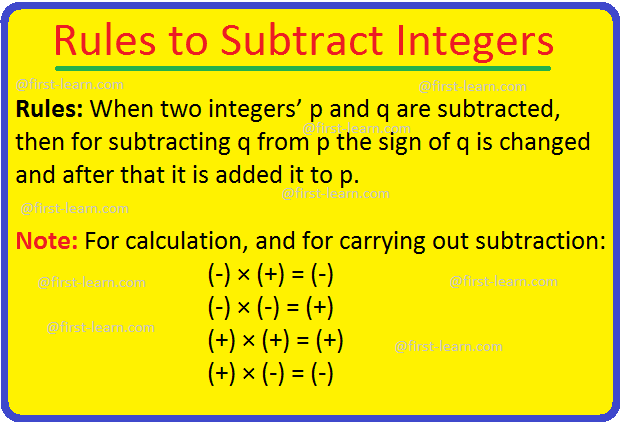Rules to Subtract Integers
Integers are positive and negative number including zero and does not include the fractional part. We will discuss about the rules for subtracting of integers. There are certain rules which will help us in better understanding of subtraction of integers. This topic will discuss how integers are subtracted when:
- One positive integer is subtracted from another positive integer.
- One negative integer is subtracted from another negative integer.
- One positive integer is subtracted from another negative integer.
- One negative integer is subtracted from another positive integer.
Rules: When two integers’ p and q are subtracted, then for subtracting q from p the sign of q is changed and after that it is added it to p.
Note: For calculation, and for carrying out subtraction:
- (-) × (+) = (-)
- (-) × (-) = (+)
- (+) × (+) = (+)
- (+) × (-) = (-)
When two signs are written side by side then it is considered that the two signs are multiplied.
Few examples are solved here using the rules of subtraction of integers mentioned above:
1. Subtract 10 from 5
5 – (+10)
Þ 5 – 10 = - 5
Here according to the rule negative sign and positive sign [i.e. (-) × (+) = (-)] makes negative sign. That is why – (+10) will be – 10. So it will be 5 – 10 = -5. Actually the absolute values are subtracted and in the result the value with a higher absolute value is considered.
2. Subtract -11 from 16
16 – (-11)
Þ 16 + 11 = 27
Here according to the rule negative sign and negative sign [i.e. (-) × (-) = (+)] makes positive sign. That is why – (-11) = +11. So it will be 16 + 11 = 27. Here both 16 and 11 is added to get 27.
3. Subtract 9 from -6
= - 6 – (+9)
= - 6 – 9
= -15
Here according to the rule negative sign and positive sign [i.e. (-) × (+) = (-)] makes negative sign. That is why – (+9) will be -9. So it will be - 6 – 9 = -15. Actually the absolute values are added and the result will have negative sign as both the numbers are negative.
4. Subtract -11 from -5
= -5 – (-11)
= -5 +11
= 6
Here according to the rule negative sign and negative sign [i.e. (-) × (-) = (+)] makes positive sign. Therefore – (- 11) = 11. So it will be -5 + 11 = 6. Actually the absolute values are subtracted and in the result the value with a higher absolute value is considered.
5. Subtract -5 from 16
= 16 – (- 5)
= 16 + 5
= 21
Here according to the rule negative sign and negative sign [i.e. (-) × (-) = (+)] makes positive sign. Therefore – (-5)= +5. So it will be 16 +5 = 21. Here both 16 and 5 is added to get 21.
From Rules to Subtract Integers to HOME PAGE
Recent Articles
-
What Is Plasma? | Blood Plasma | Proteins | Nutrients | Cholesterol
Nov 07, 25 10:29 AM
Blood is a mobile fluid which is a connective tissue and is derived from the mesoderm like cell any other connective tissue. Colour of blood is reddish and that flows inside the blood vessels by means… -
Disorders of Respiratory System | Tuberculosis | Pleurisy | Emphysema
Oct 28, 25 11:39 PM
Tuberculosis is very common disease and is caused by a type of bacteria called Mycobacterium tuberculosis. This disease causes different trouble in the respiration and infection of several parts of th… -
Regulation of Respiration | Respiratory Centres | Inspiratory Area |
Oct 14, 25 12:13 AM
Respiratory Centre is the area that controls the rate of respiration and it is observed to be located in medulla oblongata and pons. Respiratory Centre has the following will dispersed components like… -
Explain Transport of Gases | External Respiration | Tissue Respiration
Oct 09, 25 11:35 PM
In humans gaseous exchange is completed in the following ways the steps are - External Respiration or Breathing - Breathing in false taking in of Oxygen and giving out of carbon dioxide in the body. M… -
Kind and Number of Teeth | Location of Teeth in Mouth | Care of Teeth
Sep 11, 25 12:52 AM
Kind and Number of Teeth






New! Comments
Have your say about what you just read! Leave me a comment in the box below.